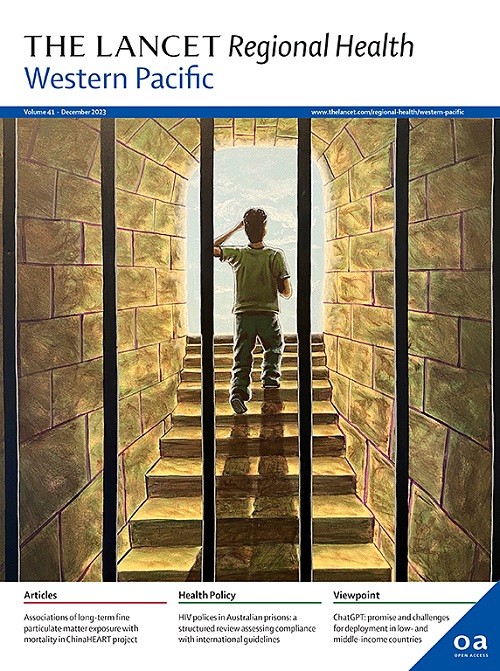1990 - 2021年中国肝癌负担和潜在病因趋势
IF 7.6
1区 医学
Q1 HEALTH CARE SCIENCES & SERVICES
引用次数: 0
摘要
肝癌仍然是一个具有挑战性的全球健康问题。2020年,中国占全球肝癌新发病例的45.3%。肝癌的高发病率和死亡率凸显了其深远的影响,反映在中国的5年生存率仅为12.1%,这给管理和治疗这种疾病带来了重大挑战。方法肝癌的患病率、发病率、死亡率和残疾调整生命年(DALY)的病例数、年龄特异性率和年龄标准化率(ASRs)(《国际疾病分类》第十版[ICD-10])数据:从《2021年全球疾病负担研究》中提取了1990年至2021年间中国的C22.0-22.8和C22.9的比例)及其六种病因(乙型肝炎、丙型肝炎、酒精使用、其他原因、NASH和肝母细胞瘤)。使用公式(1 -死亡率/发病率)×100估计5年相对生存率。肝癌负担的时间趋势由百分比变化和年均百分比变化(AAPC)确定。通过分解分析了解人口老龄化、人口增长和流行病学变化对观测趋势的贡献。在2021年,肝癌的患病率、发病率、死亡率和DALYs分别为265,539、196,637、172,068和4,890,023。相应的年龄标准化率分别为13.29 (95% UI: 10.75 ~ 16.41)、9.52 (95% UI: 7.72 ~ 11.78)、8.35 (95% UI: 6.80 ~ 10.29)、239.91 (95% UI: 191.98 ~ 299.37) / 10万。肝癌的患病率、发病率、死亡人数和残疾调整生命年呈上升趋势,主要是由于人口老龄化,然后是人口增长。同时,年龄标准化死亡率和DALY率呈下降趋势,AAPCs分别为-0.32% (95% CI: -0.35%至-0.27%)和-0.79% (95% CI: -0.86%至-0.71%)。按六种病因分层,乙型肝炎、丙型肝炎、酒精使用、NASH和其他原因导致的肝癌在发病率、流行率、死亡率和DALYs方面普遍呈上升趋势。相反,肝母细胞瘤的负荷呈下降趋势。2021年的肝癌负担主要由乙型肝炎、丙型肝炎和酒精使用引起。观察到肝癌负担的年龄模式差异,5年相对生存率随年龄下降,总体为12.27%,距离2030年15%的目标不远。本研究提供了1990年至2021年中国不同性别和潜在病因的肝癌负担的全面概述。肝癌的发病率、患病率、死亡率和DALY呈上升趋势,主要受人口老龄化驱动,其次是人口增长。2021年,肝癌负担主要由乙型肝炎、丙型肝炎和饮酒引起。该研究还确定了肝癌负担的双重模式:肝母细胞瘤的儿童高峰和老年人的成年高峰。这些关于性别、病因和年龄差异的见解增强了全国对肝癌负担流行病学变化的认识。这些发现可以为在中国开发更有针对性的肝癌治疗策略提供信息。本文章由计算机程序翻译,如有差异,请以英文原文为准。
Trends in burden of liver cancer and underlying etiologies in China, 1990−2021
Background
Liver cancer remains a challenging global health issue. In 2020, China accounted for 45.3% of new liver cancer cases worldwide. The high incidence and mortality rates of liver cancer highlight its profound impact, reflected in a mere 12.1% 5-year survival rate in China, posing significant challenges in managing and treating this disease.
Methods
Data on the number of cases, age-specific rates and age-standardized rates (ASRs) of prevalence, incidence, death, and disability-adjusted life year (DALY) attributed to liver cancer (International Classification of Diseases, 10th revision [ICD-10]: C22.0-22.8 and a proportion of C22.9) and its six etiologies (liver cancer due to hepatitis B, hepatitis C, alcohol use, other causes, NASH and hepatoblastoma) in China between 1990 and 2021 were extracted from the Global Burden of Disease Study 2021. Five-year relative survival rates were estimated using the formula (1–mortality/ incidence) ×100. Temporal trends in liver cancer burden were determined by percent changes and average annual percent change (AAPC). Decomposition analysis was conducted to understand the contributions of population aging, population growth, and epidemiological change to the observed trends.
Findings
In 2021, the number of liver cancer burden in terms of prevalence, incidence, deaths, and DALYs are 265,539, 196,637, 172,068, and 4,890,023, respectively. The corresponding age-standardized rates were 13.29 (95% UI: 10.75–16.41), 9.52 (95% UI: 7.72–11.78), 8.35 (95% UI: 6.80–10.29), 239.91 (95% UI: 191.98–299.37) per 100,000. The number of prevalence, incidence, deaths and DALYs attributed to liver cancer showed an increasing trend, primarily driven by population aging, then population growth. Meanwhile, decreasing trends were observed in age-standardized death and DALY rates, with AAPCs of –0.32% (95% CI: –0.35% to –0.27%) and –0.79% (95% CI: –0.86% to –0.71%), respectively. Stratified by six etiologies, liver cancer due to hepatitis B, hepatitis C, alcohol use, NASH, and other causes generally showed increasing trends in incidence, prevalence, death and DALYs. Conversely, the burden of hepatoblastoma showed a decreasing trend. The liver cancer burden in 2021 was mainly caused due to hepatitis B, hepatitis C, and alcohol use. Differences in age patterns of liver cancer burden were observed, and the 5-year relative survival rates decreased by age with an overall rate of 12.27%, not far from the goal of 15% by 2030.
Interpretation
This study provides a comprehensive overview of the liver cancer burden in China across both sexes and underlying etiologies from 1990 to 2021. The incidence, prevalence, death and DALY attributed to liver cancer have shown an increasing trend, primarily driven by population aging, followed by population growth. In 2021, the burden of liver cancer was mainly caused due to hepatitis B, hepatitis C, alcohol use. The study also identified a dual pattern of liver cancer burden: a childhood peak with hepatoblastoma and an adulthood peak among the elderly. These insights into variations by sex, etiology and age enhance the national understanding of epidemiological changes in liver cancer burden. These findings could inform the development of more targeted strategies to address liver cancer in China.
求助全文
通过发布文献求助,成功后即可免费获取论文全文。
去求助
来源期刊

The Lancet Regional Health: Western Pacific
Medicine-Pediatrics, Perinatology and Child Health
CiteScore
8.80
自引率
2.80%
发文量
305
审稿时长
11 weeks
期刊介绍:
The Lancet Regional Health – Western Pacific, a gold open access journal, is an integral part of The Lancet's global initiative advocating for healthcare quality and access worldwide. It aims to advance clinical practice and health policy in the Western Pacific region, contributing to enhanced health outcomes. The journal publishes high-quality original research shedding light on clinical practice and health policy in the region. It also includes reviews, commentaries, and opinion pieces covering diverse regional health topics, such as infectious diseases, non-communicable diseases, child and adolescent health, maternal and reproductive health, aging health, mental health, the health workforce and systems, and health policy.
 求助内容:
求助内容: 应助结果提醒方式:
应助结果提醒方式:


